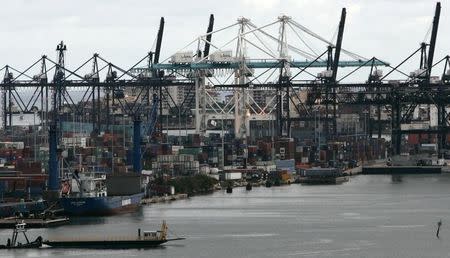Economy on solid ground despite cooler hiring
By Lucia Mutikani WASHINGTON (Reuters) - U.S. companies hired far fewer workers than expected in May, but an acceleration in services sector growth supported views the economy was regaining strength after sagging early this year. While other data on Wednesday suggested a widening trade gap could weigh on growth in the second quarter, a jump in imports pointed to a welcome pick-up in domestic demand. "May job growth may have been a little less than expected but with imports rising, it looks like the economy is moving forward solidly," said Joel Naroff, chief economist at Naroff Economic Advisors in Holland, Pennsylvania. Private employers added 179,000 jobs to their payrolls last month after hiring 215,000 workers in April, according to payrolls processor ADP. Economists had expected a gain of 210,000 private sector jobs in May. Nevertheless, many analysts said the report did not change their expectations for the government's more comprehensive jobs data due on Friday. Separately, the Institute for Supply Management said its services sector index rose to 56.3 last month from 55.2 in April as new orders, order backlogs and hiring increased. It was the highest reading in nine months. Following on the heels of data on Tuesday that showed robust growth in factory activity in May, it underscored the economy's strengthening fundamentals. Any reading above 50 indicates an expansion. The firming economic tone was highlighted by the Federal Reserve's anecdotal Beige Book. Reports from the central bank's contacts indicated activity expanded in recent weeks. In another report, the Commerce Department said the trade gap increased 6.9 percent to $47.2 billion in April as imports hit a record high and exports slipped. It was the largest deficit in two years. ANOTHER TRADE DRAG U.S. stocks shrugged off the soft reading on private sector hiring to trade mostly higher. U.S. Treasury debt prices dipped, while the dollar rose against a basket of currencies. When adjusted for inflation, the trade deficit increased to $53.8 billion from $50.9 billion in March, suggesting trade, which weighed heavily on growth in the first three months of the year, will remain a drag in the second quarter. The government said last month the economy contracted at a 1.0 percent annual pace in the first quarter, but a revision that showed the March trade deficit was wider than previously estimated suggested the economy's contraction was even sharper. But ample signs have accumulated to show activity rebounding this quarter, although growth may fall short of the 3.5 percent rate many economists had anticipated given the unexpectedly heavy demand for imports in April. Imports subtract from growth because they are produced in other countries. Goldman Sachs cut its second-quarter GDP growth estimate by four-tenths of a percentage point to a 3.4 percent rate, while Morgan Stanley slashed its forecast to a 3.5 percent rate from 4.0 percent and Barclays trimmed its estimate by one-tenth to 2.9 percent. But the 1.2 percent increase in imports also indicated domestic demand was bouncing back. Automobile, capital goods, food and consumer goods imports hit record highs in April. "Strong gains in capital and durable goods imports suggest a pick-up in economic activity and sustained domestic demand," said Gennadiy Goldberg, an economist at TD Securities in New York. The trade deficit with the European Union was the largest on record, as was the gap with the EU's biggest economy, Germany. Imports from South Korea also touched a record high. Chinese imports rose 16.3 percent, pushing the politically sensitive trade gap with China to $27.3 billion from $20.4 billion. (Reporting By Lucia Mutikani; Additional reporting by Richard Leong in New York; Editing by Andrea Ricci and Tim Ahmann)




